
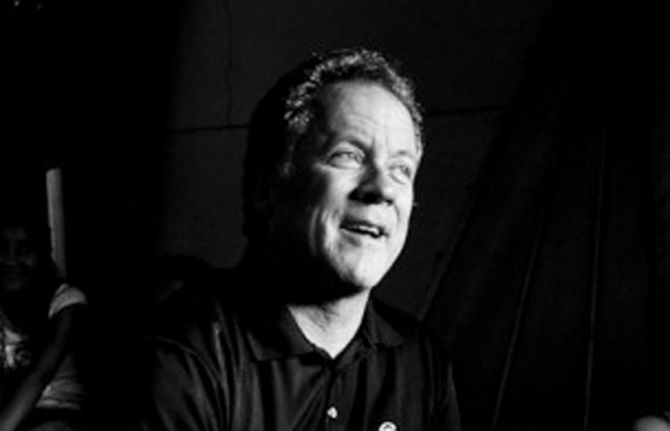
Press Statement
UNAIDS welcomes David Beasley as new Executive Director of the World Food Programme
31 March 2017 31 March 2017GENEVA, 31 March 2017—UNAIDS welcomes the appointment of David Beasley as the Executive Director of the World Food Programme (WFP).
“The appointment of David Beasley comes at a critical moment,” said UNAIDS Executive Director Michel Sidibé. “WFP’s work to achieve food security is at the heart of global efforts to break the cycle of hunger and poverty and essential to achieving the Sustainable Development Goals which include ending the AIDS epidemic.”
WFP has recently reported that more than 100 million people are facing severe food insecurity around the world and 20 million people in four countries (South Sudan, Somalia, Nigeria and Yemen) are currently facing famine.
During humanitarian crises, access to health care services and availability of medicines for people living with HIV are disrupted, and people find it hard to meet their nutritional needs, further risking their health.
WFP, a UNAIDS Cosponsor, works to integrate food and nutrition within the comprehensive care, treatment and support package for people living with HIV and/or active tuberculosis (TB). WFP also works with the Office of the United Nations High Commissioner for Refugees to ensure that food security and related needs are adequately addressed among displaced, refugee and returnee populations. Together they support HIV and TB prevention and care, as well as food and nutrition assistance activities in humanitarian emergencies.
Integrating food and nutrition components in HIV and TB treatment and support packages is critical to ensuring better health outcomes for people living HIV and/or TB. In 2015, WFP’s HIV and TB programmes reached 540 000 people.
UNAIDS
The Joint United Nations Programme on HIV/AIDS (UNAIDS) leads and inspires the world to achieve its shared vision of zero new HIV infections, zero discrimination and zero AIDS-related deaths. UNAIDS unites the efforts of 11 UN organizations—UNHCR, UNICEF, WFP, UNDP, UNFPA, UNODC, UN Women, ILO, UNESCO, WHO and the World Bank—and works closely with global and national partners towards ending the AIDS epidemic by 2030 as part of the Sustainable Development Goals. Learn more at unaids.org and connect with us on Facebook, Twitter, Instagram and YouTube.

Press Statement
UNAIDS welcomes the announcement of Gilbert Fossoun Houngbo as President of the International Fund for Agricultural Development
20 February 2017 20 February 2017GENEVA, 20 February 2017—UNAIDS extends its congratulations to Gilbert Fossoun Houngbo, former Prime Minister of Togo, who has been newly appointed as President of the International Fund for Agricultural Development.
“Mr Houngbo’s dynamic approach to leadership and his wealth of experience will be critical to strengthening the link between food and nutrition and good health, which is particularly important for people living with HIV,” said Michel Sidibé, Executive Director of UNAIDS. “Mr Houngbo's commitment to ensuring equality and creating opportunity are shared values and we look forward to working closely together to achieve the Sustainable Development Goals.”
Through his many high-level postings within government and the United Nations system, Mr Houngbo has worked to ensure that no one is left behind by providing support in areas ranging from good governance and peacebuilding to eradicating poverty and responding to HIV.
UNAIDS looks forward to working with Mr Houngbo in his new role, in which he will be supporting and empowering rural people to reduce poverty, increase food security, improve nutrition and strengthen resilience, all of which are essential elements to an effective response to HIV.
UNAIDS
The Joint United Nations Programme on HIV/AIDS (UNAIDS) leads and inspires the world to achieve its shared vision of zero new HIV infections, zero discrimination and zero AIDS-related deaths. UNAIDS unites the efforts of 11 UN organizations—UNHCR, UNICEF, WFP, UNDP, UNFPA, UNODC, UN Women, ILO, UNESCO, WHO and the World Bank—and works closely with global and national partners towards ending the AIDS epidemic by 2030 as part of the Sustainable Development Goals. Learn more at unaids.org and connect with us on Facebook, Twitter, Instagram and YouTube.
Press centre
Download the printable version (PDF)

Press Statement
UNAIDS calls for improved access to condoms for all who need them
13 February 2017 13 February 2017GENEVA, 13 February 2017—On International Condom Day, UNAIDS is calling for countries to remove barriers that hinder access to, and the use of, condoms. Condoms are an effective means of preventing HIV and sexually transmitted infections. With the annual number of new HIV infections among adults remaining static at 1.9 million for the past five years, and increasing in some parts of the world, there is an urgent need for improved access to HIV prevention options, including condoms and lubricants. For example, the gap between availability and need in sub-Saharan Africa—the region most affected by HIV—is estimated to be more than 3 billion condoms.
UNAIDS supports creative and strategic thinking around innovative approaches to improving condom availability. Countries should make condoms available for free or at a low cost through their public health facilities and engage in imaginative marketing strategies and distribution systems, including social enterprises and community-based programmes.
In 2015, there were 2.1 million new HIV infections. Increasing access to condoms is a critical element to meeting the target of fewer than 500 000 new HIV infections by 2020—an important milestone in efforts to end the AIDS epidemic by 2030.
UNAIDS
The Joint United Nations Programme on HIV/AIDS (UNAIDS) leads and inspires the world to achieve its shared vision of zero new HIV infections, zero discrimination and zero AIDS-related deaths. UNAIDS unites the efforts of 11 UN organizations—UNHCR, UNICEF, WFP, UNDP, UNFPA, UNODC, UN Women, ILO, UNESCO, WHO and the World Bank—and works closely with global and national partners towards ending the AIDS epidemic by 2030 as part of the Sustainable Development Goals. Learn more at unaids.org and connect with us on Facebook, Twitter, Instagram and YouTube.
Press centre
Download the printable version (PDF)

Press Statement
UNAIDS calls for all women living with HIV to have timely access to cervical cancer screening
03 February 2017 03 February 2017GENEVA, 4 February 2017—On World Cancer Day, UNAIDS is calling for all women living with HIV to have access to information about the human papillomavirus (HPV) and to be offered cervical cancer screening and treatment if necessary.
Cervical cancer is preventable and, if caught early, treatable. However, around half of the estimated 500 000 women who are diagnosed with cervical cancer every year die from the disease. Nine out of 10 women who die from cervical cancer live in low- and middle-income countries. It is projected that this number could double by 2035 if cervical cancer prevention, screening and treatment efforts are not urgently scaled up.
Cervical cancer is the second most common cancer among women living in low- and middle-income countries, and women living with HIV are particularly affected. Women living with HIV are up to five times more likely to develop cervical cancer than women who do not have the virus, highlighting the importance of urgent access to cervical cancer screening, and treatment when needed, for all women living with HIV.
Most cervical cancer is caused by HPV. Women with healthy immune systems are likely to clear an HPV infection over time. However, women living with HIV have compromised immune systems and are far less likely to be able to clear an HPV infection. HPV infection has also been found to significantly increase the risk of HIV transmission for both men and women.
To effectively reduce deaths from cervical cancer, investments need to be made in health education, HPV vaccination for adolescent girls, screening, together with counselling and information, and access to treatment and care when needed.
The relationship between HPV and HIV offers significant opportunities to reduce the impact of both viruses as existing HIV programmes could play a vital role in expanding cervical cancer prevention, screening and treatment services.
The United Nations Joint Global Programme on Cervical Cancer Prevention and Control and the Pink Ribbon Red Ribbon partnership are examples of successful alliances. Synergies must be leveraged further with a focused and integrated approach to saving women’s lives.
UNAIDS
The Joint United Nations Programme on HIV/AIDS (UNAIDS) leads and inspires the world to achieve its shared vision of zero new HIV infections, zero discrimination and zero AIDS-related deaths. UNAIDS unites the efforts of 11 UN organizations—UNHCR, UNICEF, WFP, UNDP, UNFPA, UNODC, UN Women, ILO, UNESCO, WHO and the World Bank—and works closely with global and national partners towards ending the AIDS epidemic by 2030 as part of the Sustainable Development Goals. Learn more at unaids.org and connect with us on Facebook, Twitter, Instagram and YouTube.
Press centre
Download the printable version (PDF)

Press Statement
UNAIDS congratulates John Nkengasong on his appointment as inaugural director of the Africa Centres for Disease Control and Prevention
23 December 2016 23 December 2016World-leading virologist appointed to head new African Union-based public health body
GENEVA, 23 December 2016—John Nkengasong has been named as the first director of the Africa Centres for Disease Control and Prevention (Africa CDC). The Africa CDC is a specialized technical institution of the Africa Union, based in Addis Ababa, Ethiopia, which will provide strategic direction and promote public health practice within Member States.
“Public health is essential to the growth and development of Africa and a basic human right. I cannot think of someone better qualified to lead the new Africa CDC,” said Michel Sidibé, Executive Director, UNAIDS. “Concerted and coordinated action is needed to overcome the unnecessary burden of communicable and non-communicable diseases across the African continent. We look forward to working with the new director to end AIDS as a public health threat, achieve the Sustainable Development Goals and build the future we want for Africa through the African Union’s Agenda 2063.”
The Africa CDC aims to establish early warning and response surveillance platforms to address health emergencies quickly and effectively. It will support Member States in country-level hazard mapping and risk assessments, and emergency response planning. The institution will also work to prevent disease by strengthening health systems and by addressing communicable and non-communicable diseases, environmental health and neglected tropical diseases.
UNAIDS
The Joint United Nations Programme on HIV/AIDS (UNAIDS) leads and inspires the world to achieve its shared vision of zero new HIV infections, zero discrimination and zero AIDS-related deaths. UNAIDS unites the efforts of 11 UN organizations—UNHCR, UNICEF, WFP, UNDP, UNFPA, UNODC, UN Women, ILO, UNESCO, WHO and the World Bank—and works closely with global and national partners towards ending the AIDS epidemic by 2030 as part of the Sustainable Development Goals. Learn more at unaids.org and connect with us on Facebook, Twitter, Instagram and YouTube.
RESOURCES
Press centre
Download the printable version (PDF)

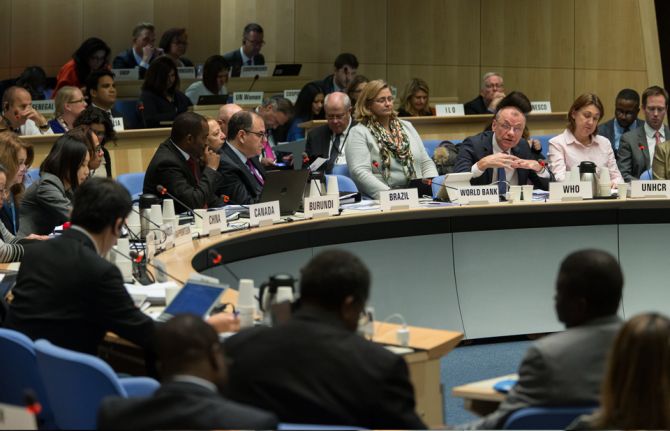
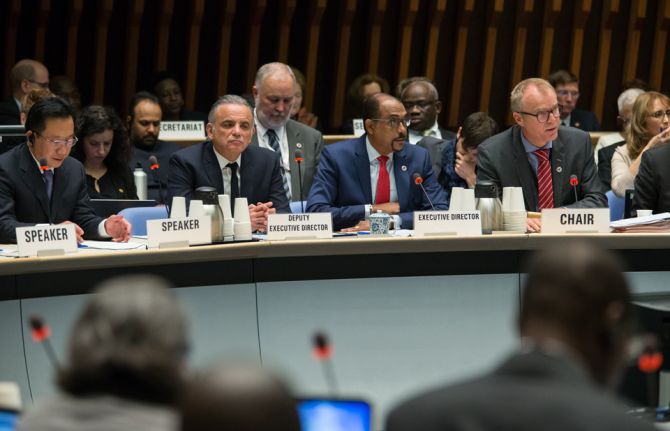
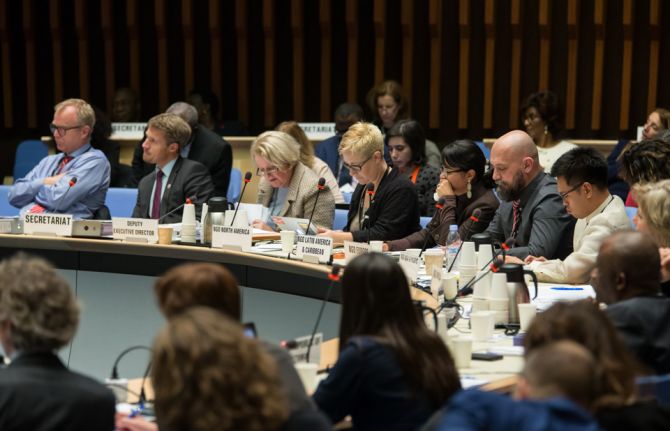
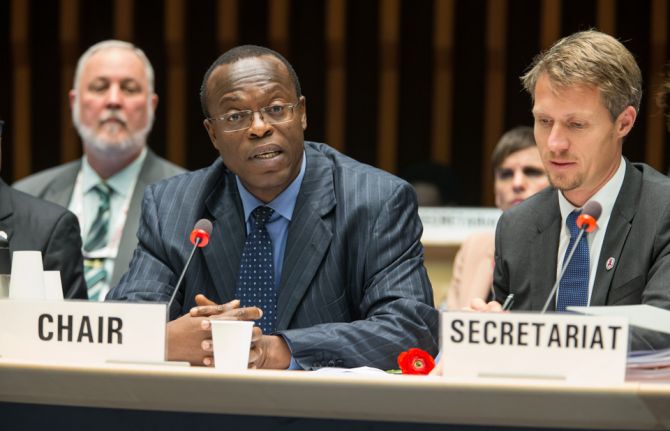
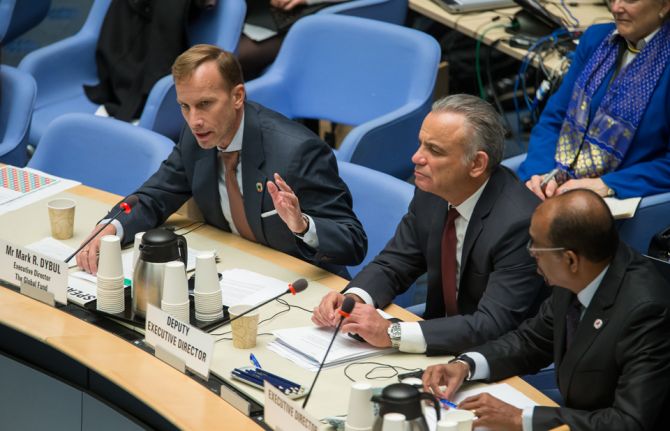
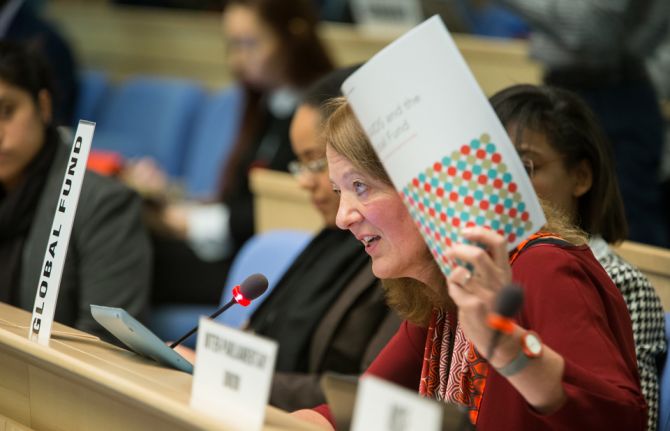
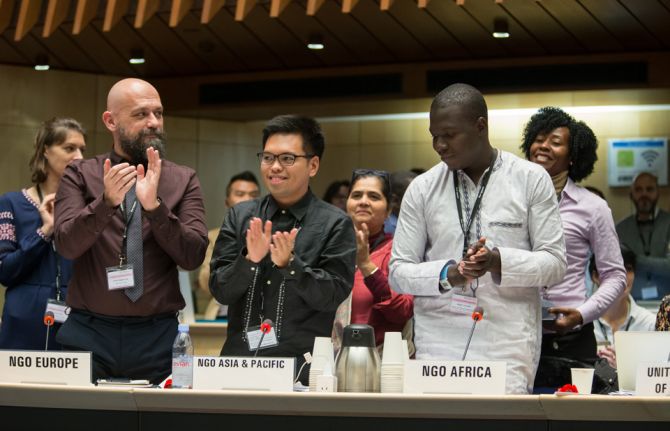
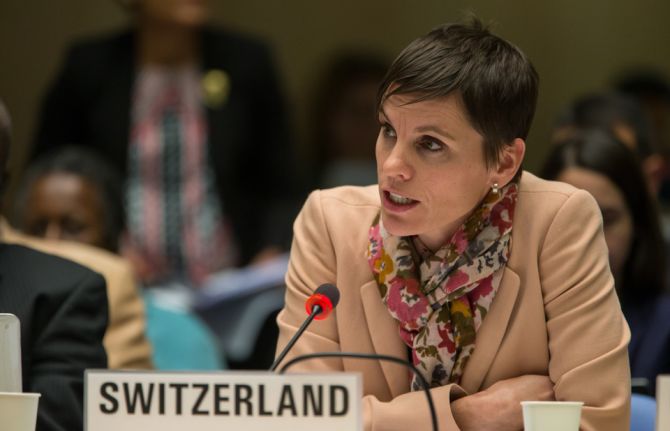
Press Statement
UNAIDS Board underlines the need for a fully funded response to HIV to allow more countries to get on the Fast-Track to ending AIDS by 2030
12 December 2016 12 December 2016GENEVA, 12 December 2016—At its 39th meeting, the UNAIDS Programme Coordinating Board welcomed the significant progress made in the response to HIV and stressed the need for sustained investment, strengthened commitment, partnerships and innovation to enable more countries to accelerate the delivery of services to end the AIDS epidemic by 2030.
In his opening address, the Executive Director of UNAIDS, Michel Sidibé, took stock of a momentous year for the AIDS response, during which access to antiretroviral therapy expanded to more than 18 million people and more countries adopted a Fast-Track response to ending the AIDS epidemic by 2030. A Fast-Track response includes a set of measurable targets that must be reached by 2020 in order for the world to be on course to end the AIDS epidemic by 2030.
Mr Sidibé underlined the need to continue to respond to the underlying issues that increase the vulnerability of people to HIV infection, particularly specific groups of people, including young women and adolescent girls and key populations, such as sex workers, transgender people, gay men and other men who have sex with men, prisoners and people who inject drugs. He announced plans for a new prevention coalition across different initiatives and among different leaders, implementers and community representatives committed to closing the prevention gap.
Despite the progress made in responding to HIV, Mr Sidibé warned of emerging global challenges that threaten to blow the Fast-Track response off course.
“It is essential that countries continue to have access to long-term, predictable and sustainable resources,” said Mr Sidibé. “If this is not the case, they will not be able to sustain and accelerate their responses to HIV and there could be a rebound of the AIDS epidemic in the coming years.”
During its three-day meeting, the Board noted the shortfall of funding commitments to support UNAIDS’ work and emphasized the need for the Joint Programme to be fully funded. At the same time, the Board called for the intensification of efforts to eliminate new infections among children and keep their mothers alive, so as to reach the targets set out in the 2016 Political Declaration on Ending AIDS and the Start Free Stay Free AIDS Free framework. The Board welcomed the successful replenishment of the Global Fund to Fight AIDS, Tuberculosis and Malaria and called for increased investment in community-based health service delivery and in civil society partners involved in the AIDS response, as well as for the strengthening of other measures designed to enhance community involvement.
The Board emphasized that community leadership will become even more important under the Sustainable Development Goals, which require inclusive responses and reaching the people most at risk of being left behind. Community responses have been in the vanguard of the AIDS response from the very beginning, but are not a substitute for national responses; rather, they constitute an integral component of evidence-informed national implementation plans, in particular for a Fast-Track response.
During the dedicated thematic day, the Board focused on the state of the epidemic among people living with HIV and at risk of acquiring HIV aged 50 years and above, the impact of ageing with HIV and related health and social sector responses. There was broad consensus for the need to support programmes and health system structures to comprehensively meet the needs of a growing number of people living with HIV who are aged 50 or over.
Representatives of Member States, international organizations, civil society and nongovernmental organizations attended the meeting, which was chaired by Switzerland. Ghana served as Vice-Chair and Ecuador as rapporteur.
The UNAIDS Executive Director’s report to the Board and the Board’s decisions can be found at unaids.org.
UNAIDS
The Joint United Nations Programme on HIV/AIDS (UNAIDS) leads and inspires the world to achieve its shared vision of zero new HIV infections, zero discrimination and zero AIDS-related deaths. UNAIDS unites the efforts of 11 UN organizations—UNHCR, UNICEF, WFP, UNDP, UNFPA, UNODC, UN Women, ILO, UNESCO, WHO and the World Bank—and works closely with global and national partners towards ending the AIDS epidemic by 2030 as part of the Sustainable Development Goals. Learn more at unaids.org and connect with us on Facebook, Twitter, Instagram and YouTube.

Press Statement
On Human Rights Day, UNAIDS stands up for the protection and promotion of human rights for everyone
09 December 2016 09 December 2016The communities most affected by HIV must be meaningfully involved in the AIDS response if we are to overcome the stigma, discrimination and denial of human rights that continue to put people at risk of HIV and deny them access to HIV prevention and treatment services.
GENEVA, 10 December 2016—The world will never achieve the end of AIDS without bold actions to advance the human rights of the people left furthest behind. Stigma and discrimination based on health status, gender, sexual orientation, drug dependency, disability and migrant and refugee status, among others, prevent people from accessing life-saving HIV prevention, treatment, care and support services. Across the world, inequalities and injustice threaten sustainable development and perpetuate social exclusion.
“The AIDS response has demonstrated the importance of and tangible results from overcoming the human rights violations that are fuelling the epidemic,” UNAIDS Executive Director Michel Sidibé said. “The voice and leadership of people living with HIV and key populations remain essential for ending the AIDS epidemic. UNAIDS stands up for their rights and for the meaningful participation of affected communities.”
On Human Rights Day, UNAIDS calls for the world to stand up for the rights of the most discriminated against and marginalized and for an end to stigma, discrimination and human rights violations against everyone.
UNAIDS
The Joint United Nations Programme on HIV/AIDS (UNAIDS) leads and inspires the world to achieve its shared vision of zero new HIV infections, zero discrimination and zero AIDS-related deaths. UNAIDS unites the efforts of 11 UN organizations—UNHCR, UNICEF, WFP, UNDP, UNFPA, UNODC, UN Women, ILO, UNESCO, WHO and the World Bank—and works closely with global and national partners towards ending the AIDS epidemic by 2030 as part of the Sustainable Development Goals. Learn more at unaids.org and connect with us on Facebook, Twitter, Instagram and YouTube.

Press Statement
UNAIDS welcomes compelling results of progress in AIDS response from surveys supported by the United States of America in three African countries
01 December 2016 01 December 2016Investments by the United States of America in the global AIDS response are delivering results
GENEVA, 1 December 2016—Upon the release of compelling new evidence of national AIDS programme successes in Malawi, Zambia and Zimbabwe, UNAIDS congratulates the countries as well as the United States of America for its consistently outstanding support to the global AIDS response.
New survey data released by the United States President’s Emergency Plan for AIDS Relief (PEPFAR) show that Malawi, Zambia and Zimbabwe have all made important progress against the epidemic. The initial results from the three Population-Based HIV Impact Assessment (PHIA) surveys are largely consistent with national data and UNAIDS estimates.
PEPFAR announced that the PHIA surveys, led by Columbia University’s ICAP programme, provide additional evidence that the epidemic is becoming controlled among older adults and babies in Malawi, Zambia and Zimbabwe. The surveys also found that the three African countries have achieved viral load suppression among an average of 65% of all adults living with HIV. Estimates of antiretroviral treatment coverage derived from PHIA survey data are also largely consistent with UNAIDS-reported estimates of treatment coverage derived from health facility data and submitted to UNAIDS by national HIV programmes.
“These encouraging results are the fruits of a shared effort—the countries hardest hit by AIDS, working in close collaboration with the international community,” said the UNAIDS Executive Director, Michel Sidibé. “The consistent bipartisan leadership of the United States of America is a major contributor to progress in the global AIDS response. The United States President’s Emergency Plan for AIDS Relief is a critical ally in the drive to achieve the end of AIDS by 2030.”
Additional information on the PEPFAR report and UNAIDS estimates
Press centre
Download the printable version (PDF)

Press Statement
World AIDS Day message 2016
30 November 2016 30 November 20161 December 2016
Michel Sidibé, Executive Director of UNAIDS, Under-Secretary-General of the United Nations
Today, we commemorate World AIDS Day—we stand in solidarity with the 78 million people who have become infected with HIV and remember the 35 million who have died from AIDS-related illnesses since the first cases of HIV were reported.
The world has committed to end the AIDS epidemic by 2030 as part of the Sustainable Development Goals. We are seeing that countries are getting on the Fast-Track—more than 18 million people are on life-saving HIV treatment and country after country is on track to virtually eliminate HIV transmission from mother to child.
We are winning against the AIDS epidemic, but we are not seeing progress everywhere. The number of new HIV infections is not declining among adults, with young women particularly at risk of becoming infected with HIV.
We know that for girls in sub-Saharan Africa, the transition to adulthood is a particularly dangerous time. Young women are facing a triple threat: a high risk of HIV infection, low rates of HIV testing and poor adherence to HIV treatment.
Coinfections of people living with HIV, such as tuberculosis (TB), cervical cancer and hepatitis C, are at risk of putting the 2020 target of fewer than 500 000 AIDS-related deaths out of reach. TB caused about a third of AIDS-related deaths in 2015, while women living with HIV are at four to five times greater risk of developing cervical cancer. Taking AIDS out of isolation remains an imperative if the world is to reach the 2020 target.
With access to treatment, people living with HIV are living longer. Investing in treatment is paying off, but people older than 50 who are living with HIV, including people who are on treatment, are at increased risk of developing age-associated noncommunicable diseases, affecting HIV disease progression.
AIDS is not over, but it can be if we tailor the response to individual needs at particular times in life. Whatever our individual situation may be, we all need access to the tools to protect us from HIV and to access antiretroviral medicines should we need them. A life-cycle approach to HIV that finds solutions for everyone at every stage of life can address the complexities of HIV. Risks and challenges change as people go through life, highlighting the need to adapt HIV prevention and treatment strategies from birth to old age.
The success we have achieved so far gives us hope for the future, but as we look ahead we must remember not to be complacent. We cannot stop now. This is the time to move forward together to ensure that all children start their lives free from HIV, that young people and adults grow up and stay free from HIV and that treatment becomes more accessible so that everyone stays AIDS-free.
UNAIDS
The Joint United Nations Programme on HIV/AIDS (UNAIDS) leads and inspires the world to achieve its shared vision of zero new HIV infections, zero discrimination and zero AIDS-related deaths. UNAIDS unites the efforts of 11 UN organizations—UNHCR, UNICEF, WFP, UNDP, UNFPA, UNODC, UN Women, ILO, UNESCO, WHO and the World Bank—and works closely with global and national partners towards ending the AIDS epidemic by 2030 as part of the Sustainable Development Goals. Learn more at unaids.org and connect with us on Facebook, Twitter, Instagram and YouTube.
Hands up for #HIVprevention — World AIDS Day campaign
Press centre
Download the printable version (PDF)

Press Statement
16 Days of Activism: UNAIDS calls for action to keep girls in school and eliminate gender-based violence
25 November 2016 25 November 2016GENEVA, 25 November 2016—In support of the annual 16 Days of Activism against Gender-Based Violence, which begins on 25 November, the International Day for the Elimination of Violence against Women, and ends on 10 December, Human Rights Day, UNAIDS is calling for urgent action to keep girls in school, end gender-based violence and reduce girls’ vulnerability to HIV.
Making sure that girls have access to schooling, particularly secondary education and comprehensive sexuality education, drastically reduces their risk of unintended pregnancy and infection with HIV and other sexually transmitted infections. It can also play a central role in empowering girls and young women to prevent gender-based violence.
“Adolescent girls and young women must have access to the information they need to make confident decisions about their health, their bodies and their future,” said UNAIDS Executive Director, Michel Sidibé.
A new report released by UNAIDS ahead of World AIDS Day on 1 December, Get on the Fast-Track: the life-cycle approach to HIV, shows that 15–24 years of age is an extremely dangerous time for women. In 2015, around 7500 young women became infected with HIV every week. Young women who have no formal education are twice as likely to become infected with HIV than young women who have some schooling.
Educated young women have more opportunities in the labour market and are more likely to be financially independent. In general, they marry at a later age and have children when they are older and are better equipped for the challenges of raising a family. The realization of women’s sexual and reproductive health and rights and the advancement of women’s empowerment are crucial to reducing the impact of the HIV epidemic.
UNAIDS
The Joint United Nations Programme on HIV/AIDS (UNAIDS) leads and inspires the world to achieve its shared vision of zero new HIV infections, zero discrimination and zero AIDS-related deaths. UNAIDS unites the efforts of 11 UN organizations—UNHCR, UNICEF, WFP, UNDP, UNFPA, UNODC, UN Women, ILO, UNESCO, WHO and the World Bank—and works closely with global and national partners towards ending the AIDS epidemic by 2030 as part of the Sustainable Development Goals. Learn more at unaids.org and connect with us on Facebook, Twitter, Instagram and YouTube.
Press centre
Download the printable version (PDF)
